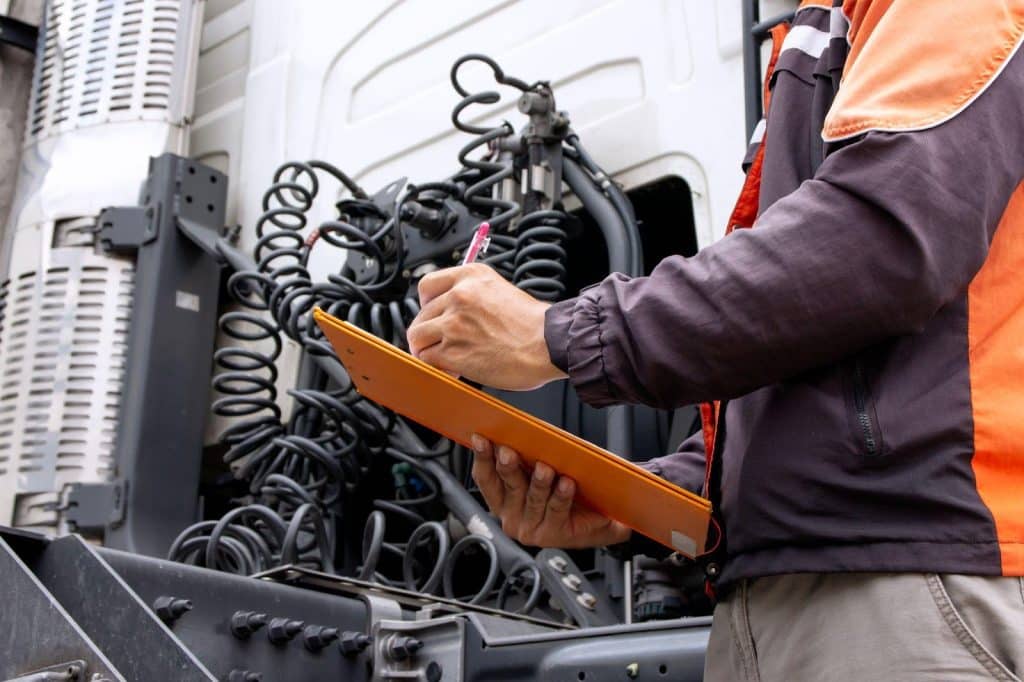
Managing a fleet of vehicles or equipment can be daunting, but it doesn’t have to be. With the right tools for the job, your equipment management woes can become a thing of the past.
In this article, we will review the equipment management process, and using some strategic planning and tools, we will transform the process into a streamlined thing of beauty. So, if you’re tired of losing track of maintenance reports, equipment repairs, or even equipment projected maintenance and longevity, stick around because I’ve got a few tips you won’t want to miss. We’re even going to talk about equipment compliance management, so let’s get started with that.
Compliance and Record-Keeping for Efficient Equipment Management

Equipment at a workplace can take a great many different forms. Some of the most common, however, include the following but are not limited to them:
- Personal protective and safety equipment
- Examples include:
- Fall prevention harnesses and lanyards
- Atmospheric testers for confined spaces
- Examples include:
- Vehicular equipment
- Examples include:
- Forklifts
- Telehandlers
- Reach trucks
- Tractor-trailers
- Examples include:
- Industry-specific equipment
- Examples include:
- Healthcare: MRI machines, X-ray machines
- Construction: Concrete mixers, bulldozers, cranes
- Security and Policing: firearms, flashlights, batons
- Utilities: Service vehicles, arc-flash equipment
- Manufacturing: Packaging equipment, sorting equipment
- Examples include:
Each example has specific documentation, inspection, and use requirements. Understanding your legal needs for each type of equipment is an absolute requirement you cannot ignore. Let’s review some of the common forms of equipment and the compliance and record-keeping requirements generally in place.
Forklifts, Scissor lifts, Telehandlers, And Other Mobile Self-Propelled Vehicles
Typical Compliance Requirements:
- Daily/Pre-use inspections – must have a document on record proving your team member(s) do the assessments to ensure safe operation and use
- Annual safety inspections – must have a documented yearly inspection performed by a certified technician.
Tips for Efficient Equipment Management
- Use an equipment maintenance checklist for the equipment to ensure every maintenance occurs using a standardized pre-approved procedure.
- Maintain templates like Equipment Condition Reports, so your team has the correct documentation.
- Use a digital platform like 1st Reporting for team member field inspections of equipment. This application is beneficial if you have field teams that utilize various types of equipment in the field.
Personal Protective Equipment
Typical Compliance Requirements:
- Pre-use inspection is required. Ensure documentation exists and is kept on-site for future reference. If working at remote sites, maintain strict documentation controls to ensure your field operations maintain documentation and inspection compliance.
- The annual equipment inspection is recommended but not required due to daily or pre-use inspection documentation.
Tips for Equipment Management
- Utilize standardized PPE inspections to ensure all team members use the same methodology for their personal protective equipment.
- Again we recommend that if you have field operations or multiple locations, use a robust reporting system like 1st Reporting.
Industry Specific Equipment
Typical Compliance Requirements:
- Industry and use-specific requirements
- Typical unstated compliance requirements would include how government agencies such as OSHA deem it a legal requirement that employers provide safe working conditions. Equipment that threatens workers in any way must adhere to strict safety standards. If you are unsure, assume that documentation is necessary for any type of equipment and always inspect any equipment before use.
Tips for Equipment Management
- As mentioned, we recommend that any equipment faces a pre-use inspection. Most accidents are preventable, so ensuring you and your team are doing your due diligence to avoid injuries with equipment must involve pre-use safety inspections of said equipment.
Understanding Compliance Requirements
Depending on the industry, the nature of the equipment, and many other factors, it can be challenging to wrap your head around equipment compliance requirements. As mentioned above, specific rules exist for the frequency of inspections and safety audit documentation in some particular equipment types.
Generally, most equipment use will fall under the essential compliance and regulatory requirements noted below. However, in the interest of safety, it is essential that you check with local authorities in your region to ensure absolute regulatory compliance regarding your equipment use.
Post Fabrication Audit
You are usually required to inspect equipment following fabrication to ensure safe and appropriate operation. Quality control procedures are in place in most manufacturing equipment to ensure product quality.
Pre-Use Inspections
The pre-use documented inspection is one of, if not the essential, equipment compliance. Particularly critical to PPE and powered equipment, ensuring that a pre-use assessment occurs appropriately and is documented for your records is necessary when using equipment that provides safety or opportunities for injury or accident.
Quarterly, Annual, and Scheduled Inspections
Most powered equipment used in workplaces, especially self-propelled vehicles, require, at minimum, an annual safety inspection. Items like forklifts, scissor lifts, and telehandlers fall into this category. A reputable and certified technician or service provider performs the off-site assessment. However, some forms of heavy equipment have mobile inspectors that might go right to one of your job sites or locations to complete the equipment inspection on-site.
Damaged or Dangerous Equipment
Whenever equipment audits happen, damage or hazardous equipment observations occur, the first thing required is to remove that equipment from service. This act often involves locking out and tagging the equipment for repair or permanent removal from service.
The bottom line for compliance is regular inspections, pre-use audits, and documentation.
Importance Of Maintaining Accurate Records
Why maintain your equipment inspections? Well, in many regions, it’s the law. For any type of equipment that could, if misused, cause harm to a person or property, you likely need to maintain records. Records of use and pre-trip inspections are no strangers to the logistics industry, but sometimes other sectors forget the importance of maintaining accurate equipment records.
Legal Requirement
As mentioned, maintaining records of equipment use is a legal requirement in many regions.
Predictive Failure
By performing and documenting regular inspections of equipment, we can start to see patterns in wear and damage. This perspective allows you to predict equipment failure with a much higher accuracy than would otherwise be possible.
Tips For Efficient Record-Keeping
There’s only one way to efficiently and effectively inspect and track your equipment: using a digital reporting system like 1st Reporting.
Sure, you can print out our Equipment Inventory Control Template; that’s all good if you only have a few pieces of equipment to track. However, when you get to over ten pieces of equipment or have equipment that goes into the field, remote sites, or client sites, you need a more robust solution than a printed template.
1st Reporting makes equipment management easy with its fast-operating downloadable app on Google Play and The Apple App Store. Your team can easily complete field equipment inspections and submit reports from anywhere. On the other hand, you can stay in the comfort of your office and receive custom notifications letting you know when your team completes an equipment inspection. These features, in turn, allow you to better manage your teams based on inspection forms and procedures you mandate necessary for their workday responsibilities.
For example, let’s say you have a fleet of field technicians operating your service vehicles. You could institute a pre-trip inspection using the 1st Reporting app that team members must complete before starting for the day. You could set up a notification so that the moment your crews conduct their pre-trip inspections, you are notified. Do you see how this sort of setup can help you a) ensure safety is a top priority and b) make managing your teams more efficient?
Equipment and Vehicle Inspections and Maintenance

The Importance Of Regular Inspections And Maintenance
Regular inspections and maintenance are the bread and butter of equipment used in the workplace. Regular inspections, such as the pre-trip inspections mentioned for self-propelled equipment, are crucial for maintaining safety and compliance. Most regions possess laws that deem it critical to the pre-use vehicle or equipment inspection. If you want your team to work safely and maintain compliance, then regular equipment inspections and maintenance are necessary.
Tips For Setting Up A Maintenance Schedule
Setting up maintenance schedules isn’t as complicated as you might think. Each type of equipment should have a manufacturer-recommended maintenance schedule, so usually, setting it up is as easy as looking at the manual and marking your calendar. However, in the interest of not losing track of maintenance, here are a few tips to help you set up your equipment maintenance schedules the right way:
- Identify all equipment that requires maintenance. Make a list of all equipment that requires maintenance, including the frequency of maintenance needed for each piece of equipment.
- Determine the maintenance tasks required for each piece of equipment. Identify the maintenance tasks your teams need to perform for each piece of equipment. These tasks may include cleaning, lubrication, calibration, and parts replacement.
- Establish a maintenance schedule. Establish a maintenance schedule based on the frequency of maintenance required for each piece of equipment and the maintenance tasks required. This schedule should specify the date on which each maintenance task needs completion.
- Use technology to streamline the process. Consider using technology to help streamline the process of setting up and managing equipment maintenance schedules. For example, you could use maintenance management software that automatically generates maintenance schedules and sends reminders to maintenance personnel.
- Assign responsibility for maintenance tasks. Assign responsibility for each maintenance task to a specific individual or team. Doing so will help ensure maintenance tasks are performed consistently and on schedule.
- Establish a record-keeping system. Record all maintenance tasks, including the date, the person or team responsible for performing the job, and any notes or observations about the equipment’s condition.
- Review and adjust the maintenance schedule as needed. Regularly review the maintenance schedule to ensure it is still appropriate and effective. Adjust the plan as needed based on changes in equipment usage, maintenance requirements, or other factors.
The Benefits Of Proactive Maintenance
Proactive maintenance is a funny thing because as humans, we tend to dwell on problems and ignore them when things go well. That being said, when it comes to preventive or proactive equipment maintenance, many tend to wait until the equipment breaks. I’m sure you’ve heard the saying, “If it ain’t broke, don’t fix it.”
The problem with non-proactive maintenance is that it is too reactive. That is to say that equipment is ignored until it requires repair, at which point it must face removal from service until the repair and subsequent safety inspections are completed.
Proactive maintenance appears to cost more at face value due to the audit’s extended labor costs. However, if we were to calculate the price of a lack of proactive maintenance, we would see a pattern emerge.
The pattern predicts equipment breakdowns will occur without warning, likely at the most inopportune moments. Therefore, when we estimate the costs of downtime or even the potential for injury due to equipment failure, we quickly see that ignorance is much higher than proactive maintenance.
Technology and Equipment/Fleet Management

Overview Of Technology Solutions For Equipment And Fleet Management
If it’s one thing that technology does well for us is that it helps to organize and maintain records and data. Equipment and fleet management are no exception.
Equipment management solutions come in various types, user experiences, and usefulness. However, after carefully reviewing many types and styles of equipment management platforms, it stands to reason that the best platforms offer a convenient and all-encompassing solution.
Let’s take the 1st Reporting app as our example of an all-encompassing audit solution for your equipment.
Equipment management includes managing safety inspections, incidents involving your equipment, repairs, maintenance, and more, depending on the type of equipment. With 1st Reporting’s powerful custom form builder, you are limited to your imagination on which forms, checklists, or documents you create and use inside the app.
Furthermore, the 1st Reporting app takes management of completed reports and amplifies the concept of a clean and user-friendly report management dashboard to the next level. The dashboard has a customizable map view that lets you easily filter and see your completed reports from your facility and around your area. You can customize your view to see specific reports in specific areas and even get a great picture of where your team member completed their reports in the field and at remote locations or job sites.
Using technology for managing your equipment is the smart move because the old way of doing things would, with today’s safety standards and requirements, take most of your time. Completing manual reports in the field also poses many other challenges, including, but not limited to, bad handwriting, loss of paperwork, forgotten and empty form fields, and more. A digital application that forces users to complete each section before moving on is one-way technology that reduces or eliminates historical paperwork problems.
Benefits Of Using Technology For Tracking Maintenance, Repairs, And Inspections
By now, you should have a pretty good understanding of the many benefits of using technology to track equipment over paper reports. However, there is one distinct advantage of using digital platforms over the paper, and that comes down to trend analysis.
Imagine you have a fleet of 100 vehicles. Each vehicle goes into the field daily, so you have 100 pre-use safety inspections per day to review, compile, and make decisions regarding any damage or issues noted on the pre-inspection reports. How would you go about tracking trends in vehicle maintenance with so much paperwork flowing through daily?
As you can well comprehend, the larger the fleet, the more equipment, and the greater the challenge of managing control of the equipment. Once you get past a specific size, using an archaic paperwork system doesn’t make sense.
You need to ask yourself: Would I instead implement a digital reporting system before getting too big, or do you want to wait and try to change over when you have no choice due to growth? I don’t know about you, but I hate putting things off that I know I will have to do. In this instance, implementing digital technology for your equipment management will likely be much easier when your operations are smaller than if you try to implement it into an existing large business.
Best Practices for Efficient Equipment and Fleet Management

We have a few ideas for increasing your equipment management efficiency and ease. Similarly, we can also apply some techniques that will make your job easier and help prolong equipment life cycles. Let’s get started.
Tips For Reducing Equipment Downtime And Increasing Efficiency
I’ve reviewed several methodologies in this article to reduce equipment downtime. However, the primary method of avoiding equipment failure is regularly inspecting the equipment for wear and tear.
In all the years I managed fleets, I found that preemptive maintenance is the way to go. For example, let’s say you have a fleet of welders who work in the field, going to various customer sites to perform welding operations. You can easily avoid welder failure by scheduling regular maintenance and inspection. Routine maintenance and inspection allow your team to note components showing wear before they break. This act decreases equipment downtime.
Strategies For Maximizing The Lifespan Of Equipment And Vehicles
I cannot stress the importance of regular maintenance and inspections for all types of equipment enough. However, one primary consideration for equipment management often contributes to equipment failure: how and where the equipment storage occurs when the equipment is not in use.
- Ensure equipment storage maintains appropriate conditions.
I’ve mentioned a few times the importance of regularly inspecting your equipment. Regular inspections reveal wear and tear before part failure (most of the time). Therefore, regular maintenance can help increase the equipment’s useable lifespan.
- Perform maintenance and inspections regularly.
If you only have one or two pieces of equipment, tracking breakdowns, failures, and trends in equipment wear is easy. However, tracking breakdowns becomes considerably more challenging when you have multiple types and quantities of equipment. We recommend using a digital reporting solution like 1st Reporting to ensure you can track and create custom reports to track trends in equipment failure.
- Track breakdown trends with technology.
Ideas For Reducing Costs While Maintaining Quality
Let’s put things in perspective to summarize some of the strategies mentioned in this guide.
- The cost of incidents and injuries consistently exceeds the cost of proactive maintenance or repair. Therefore, if you include preventive maintenance practices for your equipment, you will likely save money.
- Use a digital reporting platform to ensure all aspects of a customized inspection occur. Furthermore, you can adjust settings so users cannot move on to the next part of their task before completing their previous one. With safety inspections set up in this manner, you are virtually guaranteed that team members won’t skip inspection points.
- Implement preventive maintenance schedules. Regularly scheduled maintenance allows for a few things. First, it will enable predictive repairs. For example, if you know a piece of equipment receives heavy daily use, and you know that during previous inspections, repairs to the equipment became required. You can plan for the equipment to be removed from service during the subsequent examination to complete repairs without being unexpected.
- Implement digital reporting solutions in place of expensive, outdated, paper-based solutions. You will save money from the lack of paper, ink, printing, and all the related labor that goes into printing, organizing, filing, and manually reviewing inspection reports.